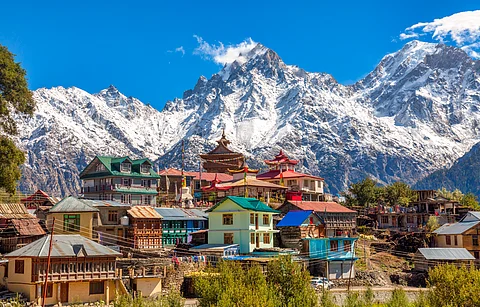

ISTOCK
Have you ever imagined waking up to a world where giant snow-capped mountains greet you from your window, where ancient temples echo with legends, and apple orchards paint the hillsides red and green? Welcome to Kalpa—a magical village high in the Himalayas, waiting quietly above the clouds for curious travellers to discover its secrets.
Kalpa isn’t a big, noisy town. In fact, if you blink while looking at a map of Himachal Pradesh, you might just miss it. But step into this tiny village, perched over 2,900 metres above sea level, and you’ll feel like you’ve entered a different world. The journey begins in the bustling town of Reckong Peo, the headquarters of Kinnaur district. From there, a winding road climbs steeply up the mountains, twisting through pine forests and past tumbling waterfalls, until you finally arrive at Kalpa—a place where the air feels crisper, and even the sun seems to shine a little brighter.
The first thing most people notice is the view. Directly in front of Kalpa rises the mighty Kinner Kailash range, a towering wall of peaks that turn gold and pink at sunrise. According to local legends, these mountains are the home of gods and spirits. Villagers will tell you stories of Lord Shiva, who is said to have meditated here, and of the mysterious rock pillar on Kinner Kailash that some believe changes colour with the seasons. Whether or not you believe in legends, it’s hard not to feel a sense of awe when standing before these ancient giants.
Kalpa itself is a maze of narrow lanes, lined with wooden houses built in the traditional Kinnauri style. Many homes have intricately carved balconies and slate roofs, and some are over a hundred years old. As you stroll through the village, you’ll pass by apple orchards—Kalpa is famous for its apples, which are shipped across India every year. In late summer and early autumn, the trees are heavy with fruit, and the air is sweet with their scent. If you’re lucky, a friendly villager might offer you a crisp, juicy apple straight from the tree.
But Kalpa is not just about spectacular scenery and delicious fruit. The village has a quiet, mystical side too. At its heart stands the ancient Narayan-Nagini Temple, decorated with colourful flags and wooden sculptures. The temple is a centre for local festivals and rituals, and if you visit during a celebration, you might see villagers dressed in traditional clothes, dancing to the beat of drums. Another must-see is the Hu-Bu-Lan-Kar monastery, founded over a thousand years ago. Step inside, and you’ll find butter lamps flickering before painted deities, and the soothing sound of monks chanting prayers.
Nature lovers will find plenty to explore. Kalpa sits in the Sutlej river valley, and the region around it is rich with wildlife. Walk quietly along the trails outside the village, and you might spot Himalayan griffons circling overhead, or even glimpse a musk deer darting through the trees. In spring, the hills burst into colour with wildflowers, and butterflies dance in the sunshine. The nights, meanwhile, are so clear that you can see countless stars—the sky seems to stretch forever, untouched by city lights.
The people of Kalpa are known for their warmth and hospitality. Life here moves at its own gentle pace. Villagers still follow age-old customs, celebrating the changing seasons and living close to nature. Many speak Kinnauri, the local language, but they’re just as happy to chat in Hindi or even a bit of English with visitors. If you’re curious, ask about their traditions—they might tell you how they weave their bright woollen caps, or share stories of the snow leopards said to roam the distant slopes.
Of course, Kalpa is not always an easy place to reach. In winter, heavy snowfall can block the mountain roads, and the whole village transforms into a silent, white wonderland. But for those who make the journey, Kalpa offers something special—a chance to step away from the rush of city life and listen to the whisper of the mountains.
ISTOCK
Keep your eyes on the sky! Kalpa is a great place to spot the Himalayan griffon vulture, a massive bird with wings wider than a school desk.
ISTOCK
The Kinner Kailash mountain, visible from Kalpa, appears to change its colours throughout the day—glowing golden at sunrise, turning pink in the afternoon, and shining silver under the moonlight.
Kalpa is famous for its juicy apples, grown in orchards that cling to the mountainsides. These apples are so tasty that they’re exported all over India!
The Narayan-Nagini Temple in Kalpa is built entirely of wood, using no nails—just cleverly carved pieces fitted together like a giant puzzle.
The Hu-Bu-Lan-Kar monastery, said to have been founded in the 11th century, is still a place of peaceful prayer and colourful festivals.
The traditional Kinnauri cap worn by villagers isn’t just for style—it shows which valley a person is from, thanks to its unique colours and patterns.
Because Kalpa is so high up, the wind often whistles through the pine trees, making it sound as if the mountains are whispering ancient secrets.
In winter, Kalpa gets so much snow that it looks like a scene straight from a storybook—with icicles hanging from rooftops and snow covering the paths.
There are no traffic lights or busy streets in Kalpa! Most people walk everywhere, and there’s more chance of meeting a herd of goats than a traffic jam.
There’s a mysterious pillar-shaped rock on Kinner Kailash, known as the “Shivling.” Locals believe it’s sacred, and it draws pilgrims from across the region.